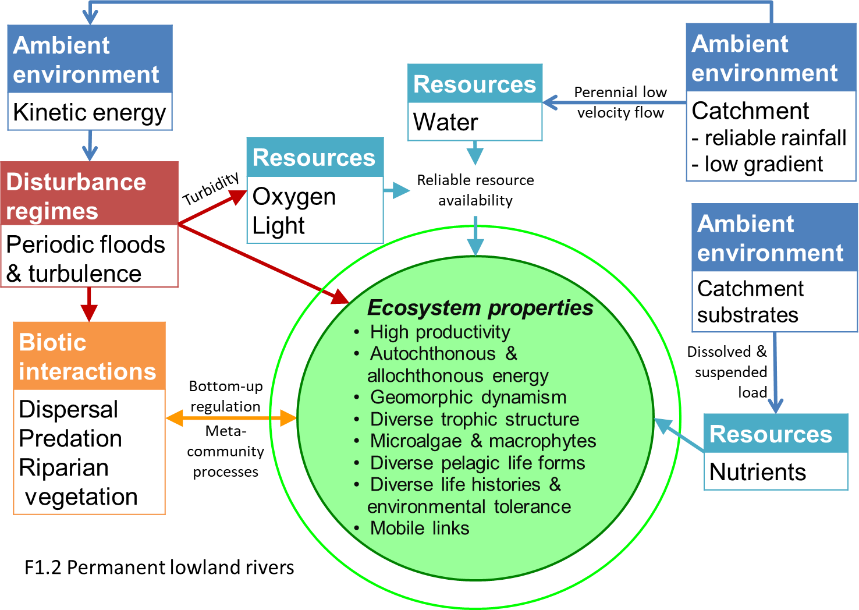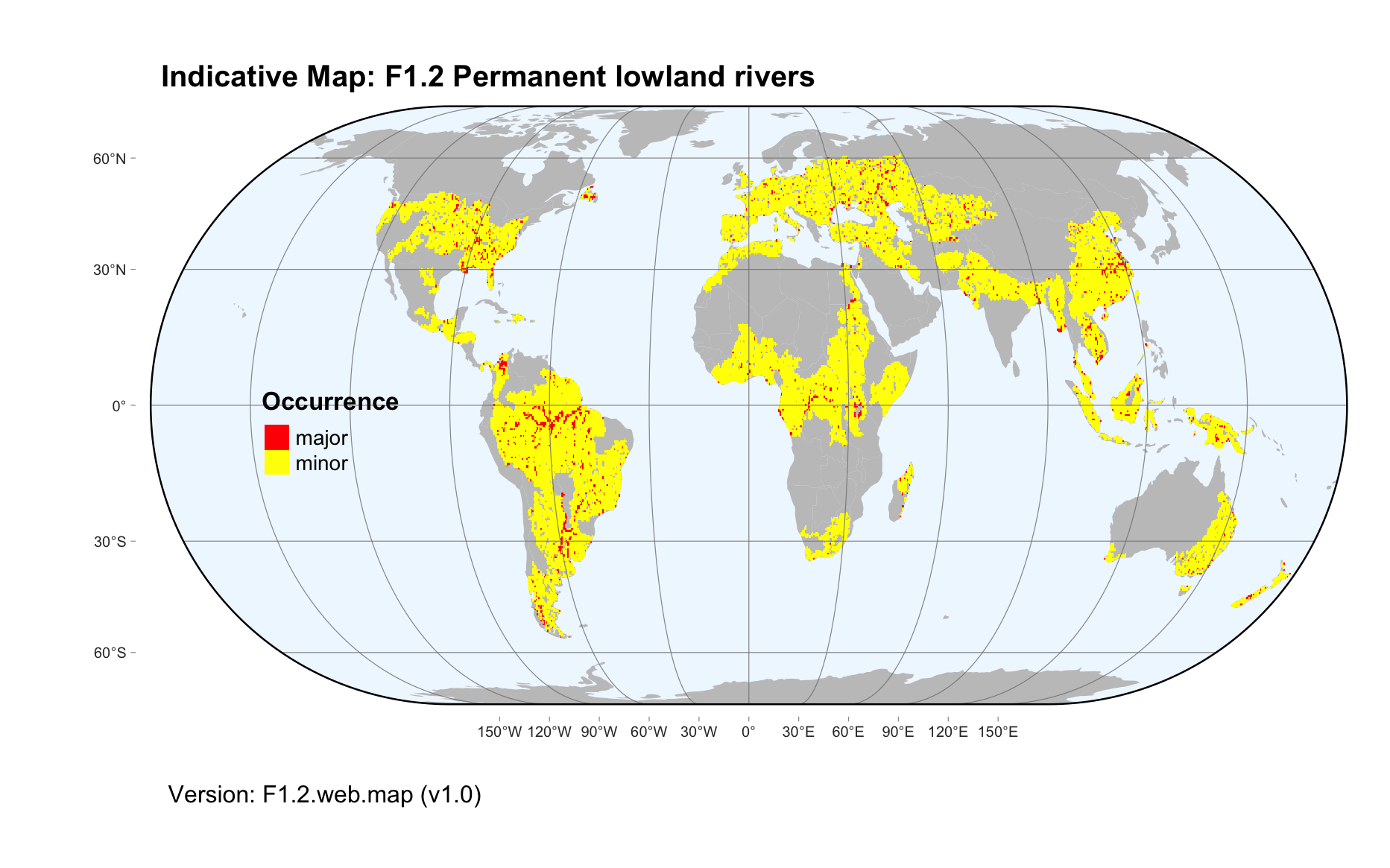Global ecosystem typology
Alternative site for the Global ecosystem typology with additional information for ecosystem profiles and indicative maps.
This site is maintained by jrfep
F1.2 Permanent lowland rivers
Biome: F1. Rivers and streams biome
Contributors:
(texts)
Lowland rivers with slow continuous flows up to 10,000m3/s are common at low elevations throughout tropical and temperate parts of the world. These are productive ecosystems with major energy and fine sediment inputs from floodplains and upper catchments. Zooplankton can be abundant, along with aquatic plants and diverse communities of fish able to tolerate a range of temperatures and oxygen concentrations, as well as reptiles, birds, and mammals that depend wholly or partly on lowland lotic aquatic habitats.
Key Features
Low-medium velocity, high volume, perennial flows with abundant zooplankton, fish, macrophytes, macroinvertebrates & piscivores.
Overview of distribution
Global lowlands fed by wet uplands.
Profile versions
- v1.0 (2020-01-20): RT Kingsford; RC Mac Nally; DA Keith
- v1.2 (2020-05-14): RT Kingsford; R Mac Nally; DA Keith
- v2.0 (2020-06-01): RT Kingsford; R Mac Nally; PS Giller; MC; Rains; AH Arthington; DA Keith
- v2.01 ():
- v2.1 (2022-04-06): RT Kingsford; R Mac Nally; PS Giller; MC; Rains; AH Arthington; DA Keith Full profile available at official site
Main references
Selected references for this functional group:
Tockner K, Malard, F, Ward JV (2000) An extension of the flood pulse concept Hydrological Processes 14: 2861-2883 DOI:10.1002/1099-1085(200011/12)14:16/17<2861::aid-hyp124>3.0.co;2-f
Diagrammatic assembly model

Maps
Maps are indicative of global distribution patterns are not intended to represent fine-scale patterns. The maps show areas of the world containing major (coloured red) or minor occurrences (coloured yellow) of each ecosystem functional group. See general notes on maps.
There are 2 alternative versions of the indicative map for this functional group, please compare description and sources below.
F1.2.IM.grid_v1.0
Datasets
- HydroAtlas-1.0
- FEOW-2008
- GSW-1.1
Map references
Linke, S., Lehner, B., Ouellet Dallaire, C., Ariwi, J., Grill, G., Anand, M., Beames, P., Burchard-Levine, V., Maxwell, S., Moidu, H., Tan, F., Thieme, M. (2019) Global hydro-environmental sub-basin and river reach characteristics at high spatial resolution Scientific Data 6: 283 DOI:10.1038/s41597-019-0300-6
Abell R, Thieme ML, Revenga C, Bryer M, Kottelat M, Bogutskaya N, Coad B, Mandrak N, Contreras Balderas S, Bussing W, Stiassny MLJ, Skelton P, Allen GR, Unmack P, Naseka A, Ng R, Sindorf N, Robertson J, Armijo E, Higgins JV, Heibel TJ, Wikramanayake E, Olson D, López HL, Reis RE, Lundberg JG, Sabaj Pérez MH, Petry P (2008) Freshwater ecoregions of the world: A new map of biogeographic units for freshwater biodiversity conservation, BioScience 58: 403–414. DOI:10.1641/B580507
Pekel JF, Cottam A, Gorelick N, Belward AS (2016) High-resolution mapping of global surface water and its long-term changes Nature 540, 418-422 DOI:10.1038/nature20584
F1.2.web.map_v1.0

Datasets
- HydroAtlas-1.0
- GSW-1.1
- FEOW-2008
Map references
Linke, S., Lehner, B., Ouellet Dallaire, C., Ariwi, J., Grill, G., Anand, M., Beames, P., Burchard-Levine, V., Maxwell, S., Moidu, H., Tan, F., Thieme, M. (2019) Global hydro-environmental sub-basin and river reach characteristics at high spatial resolution Scientific Data 6: 283 DOI:10.1038/s41597-019-0300-6
Pekel JF, Cottam A, Gorelick N, Belward AS (2016) High-resolution mapping of global surface water and its long-term changes Nature 540, 418-422 DOI:10.1038/nature20584
Abell R, Thieme ML, Revenga C, Bryer M, Kottelat M, Bogutskaya N, Coad B, Mandrak N, Contreras Balderas S, Bussing W, Stiassny MLJ, Skelton P, Allen GR, Unmack P, Naseka A, Ng R, Sindorf N, Robertson J, Armijo E, Higgins JV, Heibel TJ, Wikramanayake E, Olson D, López HL, Reis RE, Lundberg JG, Sabaj Pérez MH, Petry P (2008) Freshwater ecoregions of the world: A new map of biogeographic units for freshwater biodiversity conservation, BioScience 58: 403–414. DOI:10.1641/B580507
Check: the Glossary / Profile structure / the public document